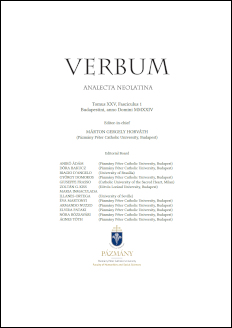Megjelent 2024-06-07
Kulcsszavak
- Bildungsroman,
- García Márquez,
- Liebestod,
- Love,
- Roland Barthes
Hogyan kell idézni
Copyright (c) 2024 Alberto Castelli

This work is licensed under a Creative Commons Attribution 4.0 International License.
Absztrakt
As lovers, we pretend perfect symmetry; the language of love is, however, essentially asymmetrical. Roland Barthes’ A Lover’s Discourse (1977) is a philosophical exploration of a lover’s inner monologue in which the chaotic flux of emotions that spring from a lover’s mind create the asymmetrical space of possibility. García Márquez’s Love in The Time of Cholera is the tale of a melancholy passion that never rises into oblivion. Florentino Ariza, the protagonist who suffers without adjustment, reenacts in fiction Barthes’s psychological mediation. By confronting his relation with time, in terms of eternity rather than future, and by encountering love with wait rather than possession, Florentino, transforms the classical Liebestod into a cathartic and transcendental experience.
Hivatkozások
- Auerbach, Erich (2003): Mimesis, trans. by Willard R. Trask. Princeton: Princeton University Press.
- Baah, R. N. (2013): Return to the past in García Márquez’s “El Amor en los tiempos del cólera.” Romance Notes 53(2): 203–212. https://doi.org/10.1353/rmc.2013.0016
- Barthes, Roland (1978): A Lover’s Discourse, trans. by Richard Howard. New York: Hill and Wang.
- Bautista, Gloria (1989): El realismo mágico en La casa de los espíritus. Discurso literario: Revista de temas hispánicos 6(2): 299-310.
- Bloom, Harold (ed.) (2007): Gabriel García Márquez. Updated Edition. New York: Chelsea House.
- Borland, Isabel Alvarez (1991): Interior Texts in El Amor En Los Tiempos Del Cólera. Hispanic Review 59(2): 175–86. https://doi.org/10.2307/473721
- Bowers, Maggie Ann (2004): Magic (al) Realism. London and New York: Routledge.
- Carney, Larry S (1987): Decadence and Modernity in the Unfinished Society: The Latin American Novel. International Journal of Politics, Culture, and Society 1(2): 291–300. https://doi.org/10.1007/BF01388243
- Carpentier, Alejo (1995): On the Marvelous Real in America. In Zamora & Farris (1995, 75–88). https://doi.org/10.2307/j.ctv11cw5w1.7
- De Lespinasse, Éléonore (1903): Letters Mlle. de Lespinasse, trans. by Katharine Prescott. Boston: Hardy, Pratt & Company.
- Fiddian, Robin (2007): A Prospective Post-Script: apropos of Love in the Times of Cholera. Gabriel García Márquez. Updated Edition, edited by Harold Bloom, New York: Chelsea House. 169–182.
- Gross, David (2000): Lost Time: Remembering and Forgetting in Late Modernity. Amherst: University of Massachusetts Press.
- Jones, Anny Brooksbank (1994): Utopia and Other Commonplaces in García Márquez’s ’El Amor En Los Tiempos Del Cólera. The Modern Language Review 89(3): 635–44. https://doi.org/10.2307/3735121
- Llosa, Vargas (1977): Remarks on the film ‘Furtivos’. Vuelta 9(46): 44–8.
- Márquez, Gabriel García (1988): Love in the Time of Cholera, trans. by Edith Grossman. New York: Alfred A. Knopf.
- Minta, Stephen (1987): Gabriel Garcia Marquez: Writer of Colombia. London: Cape.
- Monsiváis, Carlos (1985): ‘García Márquez, al margen del Nobel’. Culturas (Suplemento semanal de Diario 16) 38: i–ii.
- Palencia-Roth, M. (1991): Gabriel García Márquez: Labyrinths of Love and History. World Literature Today 65(1): 54–58. https://doi.org/10.2307/40146120
- Plato (2008): The Symposium, trans. by M. C. Howatson. New York: Cambridge University Press.
- Polka, B. (2013): Liebestod: On Love and Death in Wagner’s “Tristan und Isolde.” International Review of the Aesthetics and Sociology of Music 44(2): 239–252. http://www.jstor.org/stable/23594799.
- Swanson, Philip (1995): The New Novel in Latin America: Politics and Popular Culture After the Boom. Manchester and New York: Manchester University Press.
- Ulmer, Gregory L. (1980): The Discourse of the Imaginary. Diacritics 10(1): 61–75. https://doi.org/10.2307/465041
- Williams, Raymond Leslie (1989): The Visual Arts, the Poetization of Space and Writing: An Interview with Gabriel Garcia Marquez, PMLA 104: 131–40. https://doi.org/10.1632/S0030812900136855
- Zamora, Lois Parkinson and Faris, Wendy B. Edition (1995): Magical Realism: Theory, History, Community. Durham & London: Duke University Press. https://doi.org/10.1515/9780822397212


